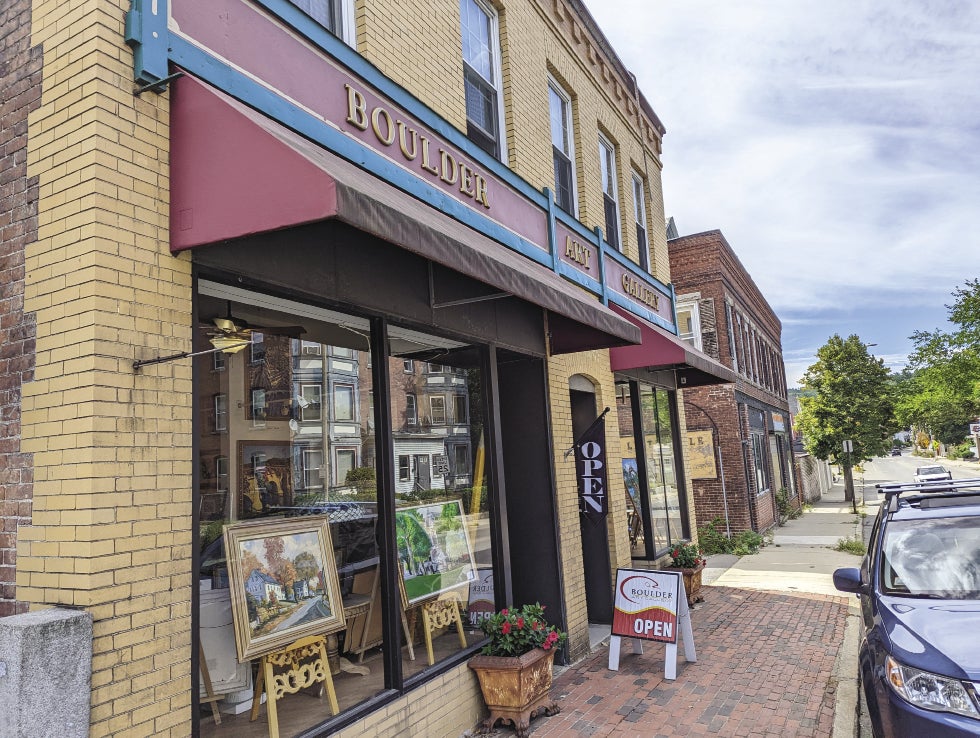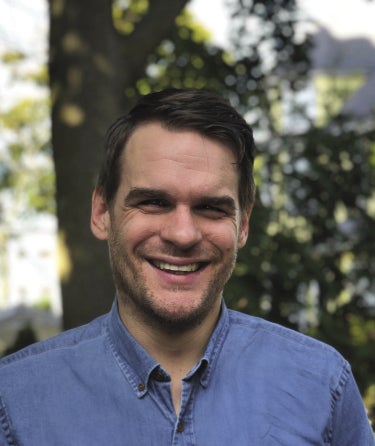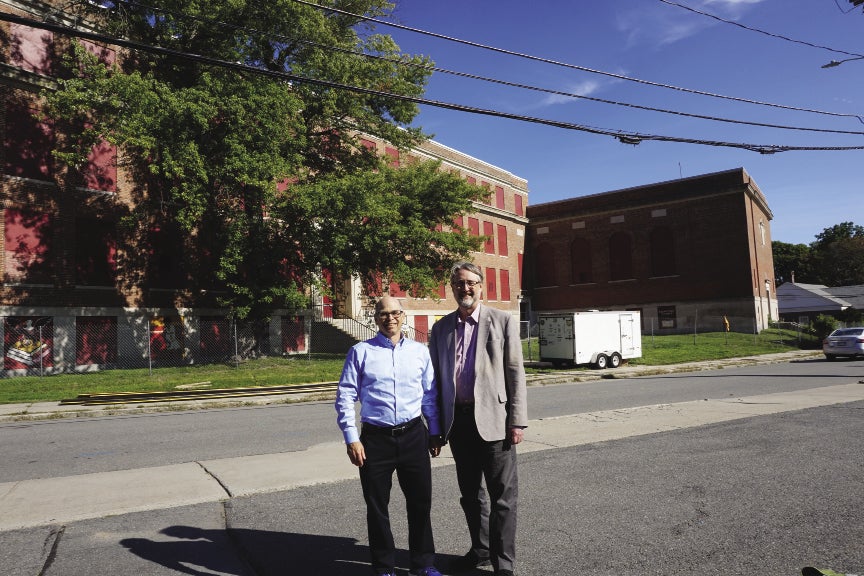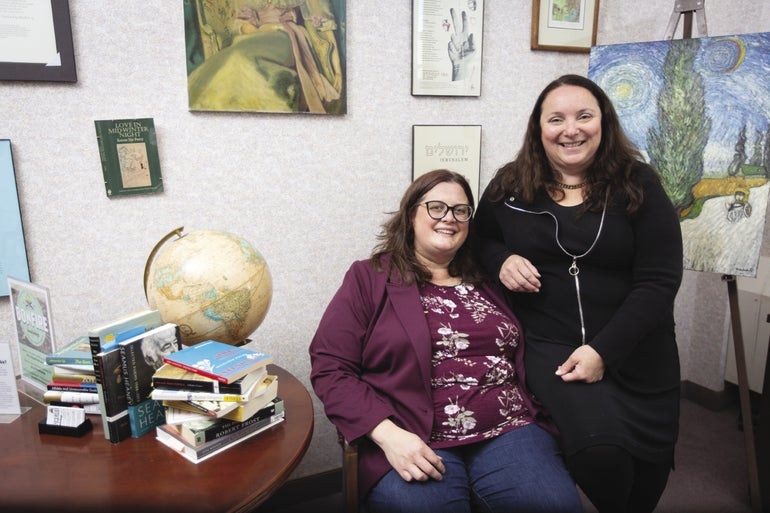Fitchburg is attempting to reclaim its artistic heritage by centering the economic development of its downtown on arts and culture.
Get Instant Access to This Article
Subscribe to Worcester Business Journal and get immediate access to all of our subscriber-only content and much more.
- Critical Central Massachusetts business news updated daily.
- Immediate access to all subscriber-only content on our website.
- Bi-weekly print or digital editions of our award-winning publication.
- Special bonus issues like the WBJ Book of Lists.
- Exclusive ticket prize draws for our in-person events.
Click here to purchase a paywall bypass link for this article.
On Main Street in Fitchburg, across from the Rollstone Boulder, a symbol of the city, is the Boulder Art Gallery, founded 14 years ago by Ann and Peter Capodagli. In addition to running the gallery, Peter is a history enthusiast who leads historic walks in the city.

“At the turn of the century, this was a railroad hub. There were hotels and over a dozen theaters. It was something people did back then: stay at one of the hotels and go see a show,” he said.
Art galleries and photography studios dotted Main Street. An art museum in Fitchburg dates back to 1885, when Rodney Wallace built the Wallace Library and Art Gallery. Then in 1925, Eleanor Norcross founded the Fitchburg Art Museum.
A center of manufacturing, Fitchburg made paper on which art was made and books were printed. Iver Johnson Arms and Cycle Works hired artisans to design bicycle frames and carve shotgun stocks.
Today, Fitchburg is attempting to reclaim that artistic heritage and centering the economic development of its downtown on the arts. Doing so involves the cooperation of city and state government entities, Fitchburg State University, arts organizations, a community development corporation, and even healthcare organizations.

“Fitchburg has always been an arts town,” said Tom Skwierawski, executive director of planning and community development for the City of Fitchburg, “We are a cultural hub in North Central Worcester County.”

Building on affordability
Fitchburg offers a more affordable alternative to Greater Boston and the MetroWest region, with a commuter rail line and easy access to Route 2 for commuting to Middlesex County.
The median price of a single-family home in Fitchburg in August was $350,000, compared to $423,000 in Leominster, $433,500 in Lowell, and $370,000 in Worcester, according to Peabody real estate data company The Warren Group. The fair market rent for a two-bedroom apartment in Fitchburg is $1,358, while in Leominster, it is $1,440, and in Worcester, $1,689, according to the U.S. Department of Housing and Urban Development.
The number of Fitchburg single-family home sales rose 24% in August vs. August 2021, compared to a 1% drop in Worcester County and a 10% drop statewide.
“We’re having no problem filling new units,” Skwierawski said. “As soon as they go on the market, they are filled.”
To help further its desirability, the city wants residents to have more to do downtown and wants to retain people who grow up in the city or go to Fitchburg State University, as well as attract workforce.
Currently downtown Fitchburg has attractive historical buildings, and a few restaurants, but many storefronts are empty.
“If we’re going to be a city of arts and culture, we need to preserve the old buildings,” said Nick Capasso, executive director of the Fitchburg Art Museum.
NewVue Communities, a nonprofit community development corporation serving northern Worcester County, has partnered with the Fitchburg Art Museum on a project to build 68 units of artist housing across from the Fitchburg Art Museum in downtown.
The project will be a restoration of three now derelict buildings including the former B.F. Brown Middle School, designed by Higgins Armory architect J. D. Leland & Co., and the former Academy Street School Annex, as well as former city stables.
NewVue bought the buildings and is in the process of turning them into live/work space. The organization is partnering with the museum and Boston’s ICON Architecture on the project. Construction on the project is expected to begin at the end of 2022 or early 2023.
The Health Foundation of Central Massachusetts in Worcester invested in the project early on, giving money for feasibility studies. UMass Memorial Health Care’s Anchor Mission program, which invests in local communities, made a below-market rate loan to the project as well.
“Because the developer is the CDC, and our mission is affordable housing, the affordability covenants for the project will remain intact,” said Marc Dohan, executive director of NewVue said.

While there will be an artist preference, the CDC must adhere to fair housing practices and make every effort to ensure the tenants of the building are representative of the community.
In developing the 68-unit project, Capasso wants to avoid artification, a play on the word gentrification used to describe the process of artists moving into an inexpensive area, causing the value of real estate to increase, leading to the displacement of people who live in the area, often including the artists themselves.

Bringing attention to the arts
Tamar Russell Brown, chair of the Fitchburg Cultural Council, owns Gallery Sitka in Shirley and a design studio called Sitka Creations. Some years ago, her gallery was in a storefront on Main Street in Fitchburg before a new landlord raised her rent.
It is difficult for a commercial gallery to make money without the density of art businesses that will attract collectors. Russell Brown believes that density is needed for the success of any retail businesses in downtown Fitchburg.
Achieving that density is difficult if people aren’t aware of the efforts to develop the downtown area, she said.
“If you’re not tapped-in to what’s going on [in the economic development and the arts scene] it’s kind of hard to see it, and to wait for it to happen,” she said. “Unless you’re in the arts, if you’re a resident here, you may not have any clue what’s going on.”
Skwierawski said as developers build new residential units downtown, often with retail space on the first floor, they will make concessions for desirable businesses.
“Forward-thinking developers will want amenities nearby for their tenants,” he said.
To make Main Street more appealing, the city made a portion of Main Street and Boulder Drive two-way to slow down drivers and make the area move pedestrian friendly. The rerouting allows the city to shut down one street or the other for festivals.
Festivals play a role in the city making itself friendly for artists and fans of culture. On Sept. 17, the city was home to the River City Rhythm & Rock Fest, a community arts and music festival at Riverfront Park. The festival was organized by local arts organizations The Thurston Consort and Young Coff33 Productions in collaboration with several local nonprofits and financed by a NewVue Communities Steward Activation Grant.
On the weekend of Sept. 24, the city hosted Fitchburg Open Studios, an event where artists open their studios to the public to show their work and some insight into how an artist works. That event is organized by the Fitchburg Cultural Council but will be handed over to the Fitchburg Cultural Alliance after this year’s event.
No magic pill
In 2016, Fitchburg State University purchased a former theater, built in 1929, at 707 Main St. and is renovating it to restore the theater to its past glory. It will seat 1,200 when it reopens in 2023. The following phase of the project will create a 200-seat black box theater.
The property contains other storefronts, one of which is occupied by the Idea Lab, a business incubation collaboration between FSU and NewVue Communities.
There is a plan for an art gallery in one of the storefronts as well.
Next to the theater property, is a former Fidelity Bank building at 675 Main St. Fidelity donated the property to Fitchburg State in 2009. Now, the school leases the property to the Fitchburg Cultural Alliance for the organization’s new headquarters, a gallery space, and artist studios.
“There’s a large artist community here,” said Russell Brown, “A lot of them are retired professors, retired teachers, people who came here for one reason or another and ended up staying. There’s quite a few from the university. These kind of organizations like the alliance want to help the younger generation who may not have the funds of the older generation for things like studios. That’s been the push of the council to help fund some of these organizations to help the younger population to do projects.”
The Fitchburg Cultural Alliance is in its 45th year. But, thanks to a MassDevelopment TDI Creative Catalyst Grant, the organization has its first full-time paid executive director in Jessie Olson and a studio manager in Tiana Burnett.
“The cultural council held a public input meeting as part of the grant process, and the two things that were wanted the most were affordable studio space and a community art center,” said Olson.
The organization is recreating the bank space into a creative space open to all media artists. It will also contain six dedicated studio spaces for artists, as well as an area for artists to use as a coworking space with office resources and a space to have meetings.
There is no one organization that can restore Fitchburg to its place as a center for arts and culture. It is a collaboration between many players.
“No one is saying that arts and culture is a magic pill. Redevelopment is a multi-pronged approach,” said Capasso.
The organizations involved share a common goal.
“You have to know who you are, and look inside for assets, rather than relying on bringing them in from outside,” Dohan said.

